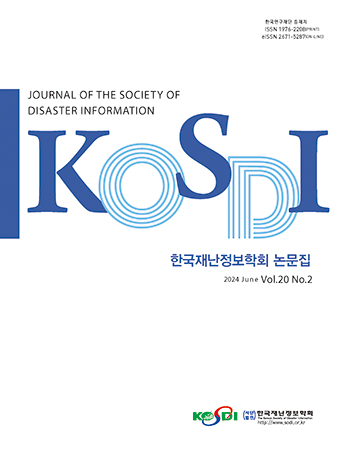Original Article
Abstract
References
Information
Purpose: This paper conducts IoT and CCTV-based safety monitoring to analyze accidents and potential risks occurring at construction sites, and detect and analyze risks such as falls and collisions or abnormalities and to establish a system for early warning using devices like a walkie-talkie and chatbot service. Method: A safety management service model is presented through smart construction technology case studies at the construction site and review a relevant literature analysis. Result: According to ‘Construction Accident Statistics,’ in 2021, there were 26,888 casualties in the construction industry, accounting for 26.3% of all reported accidents. Fatalities in construction-related accidents amounted to 417 individuals, representing 50.5% of all industrial accident-related deaths. This study suggests implementing AI chatbot services for construction site safety management utilizing IoT-based health monitoring technologies in smart construction practices. Construction sites where stakeholders such as workers participate were demonstrated by implementing an artificial intelligence chatbot system by selecting major risk areas within the workplace, such as scaffolding processes, openings, and access to hazardous machinery. Conclusion: The possibility of commercialization was confirmed by receiving more than 90 points in the satisfaction survey of participating workers regarding the empirical results of the artificial intelligence chatbot service at construction sites.
연구목적: 본 논문은 건설 시공현장에서 발생하는 사고 및 잠재적 위험분석을 위한 IoT 및 CCTV 기반 안전모니터링을 실시하고 추락, 충돌 등 위험 또는 이상현상을 탐지하여 무전기 등을 이용한 예・경보 및 챗봇서비스를 구축하는 방법을 제시하는데 목적이 있다. 연구방법: 건설현장 스마트 건설기술 사례 및 문헌분석을 통하여 안전관리 모델을 제시한다. 연구결과: ‘건설사고 통계’에 따르면 2021년 건설업 사고재해자는 26,888명으로 전체 사고재해의 26.3%가 건설업에서 발생하였고, 건설업 안전사고 사망자는 417명으로 전체 산업재해 사망자의 50.5%에 달한다. 이런한 건설재해의 개선 방안으로, IoT 건전성모니터링 기반 스마트 건설기술을 활용한 건설현장 안전관리 AI 챗봇서비스를 제시한다. 근로자 등 이해관계자가 참여하는 건설현장은 비계공정 및 개구부, 위험기계기구류 접근 등 사업장 내부 주요 위험구역을 선정하여 인공지능 챗봇시스템을 구현하여 실증하였다. 결론: 건설현장 인공지능 챗봇서비스 실증결과에 대한 참여근로자의 만족도 조사에서 90점 이상을 받아 상업화 가능성을 확인하였다.
- Cho, M.S. (2017). "Manual improvement plan for accidents prevention in maritime safety." Korean Journal of Security Convergence Management Vol. 6 No. 2, pp. 48-56. 10.24826/KOSSCOM.6.2.5
- https://blcm.go.kr/lim/etc/ServiceLif.do. Building lifecycle management system. Ministry of Land, Infrastructure and Transport.
- Jin, J.I. (2023). A Study on the Effects of Construction Industry Risk Assessment and Mobile CCTV Control System on Safety and Health Performance. Doctoral Disssertation, Department of Safety and Health Convergence Engineering Graduate School of Soongsil University.
- Kang¸ J.D., Park¸ S.H. (2023). "Evaluation of utilization of waste smartphones for measuring instruments in structural health monitoring." Journal of The Korea Institute for Structural Maintenance and Inspection, Vol. 27 No. 2, pp. 85-85.
- Kim, G.B. (2022). A Study on the Factors Affecting the Acceptance Intention of IoT-Based Smart Construction Safety Systems. Doctoral Disssertation, Department of Business Administration Graduate School of Soongsil University.
- KOSHA (2010). 4M Risk Assessment Manual.
- KOSHA (2020). 2020 Risk Assessment Guidance Commentary.
- Lee, J.W. (2022). Integrated Smart Safety System for Enhanced Construction Safety and Productivity. Doctoral Disssertation, Department of Disaster and Safety, Graduate School, Myongji University.
- María, M.R., José, M.S., María, D.M., Juan, C.R. (2022). "An analysis of occupational accidents involving national and international construction workers in Spain using the association rule technique." International Journal of Occupational Safety and Ergonomics, Vol. 28, No. 3, pp. 1490-1501. 10.1080/10803548.2021.1901433 33687309
- Ministry of Employment and Labor (2021). 2021 Industrial Accident Status Analysis. Ministry of Employment and Labor Occupational Safety and Health Headquarters, Sejong.
- Ministry of Employment and Labor (2022). KRW 1 to KRW 5 Billion Autonomous Safety Checklist for Fatal Accidents for Small and Medium-sized Construction Sites. Ministry of Employment and Labor Construction Industrial Accident Prevention Policy Division, Sejong.
- Ministry of Employment and Labor (2023). Guidelines for Workplace Risk Assessment. Ministry of Employment and Labor Notice No. 2023-19, Sejong.
- Ministry of Employment and Labor (2023). Occupational Safety and Health Act.
- Oh, T.G., Park, J.L., Lee, J.Y., Kim, C.S., Kim, J.B., Yoon, Y.G., Kang H.J., Lee, S.R., Jo, A.R., Cho, H.J., Jeon, Y.S. (2021). Report on Creating a Smart Construction Safety Technology Analysis and Distribution Base. Korea Occupational Safety and Health Agency, Ulsan.
- Park, J.H., Lee, T.J., Hong, Y.G., Youn, J.S. (2023). "Intelligent bridge safety prediction edge system." KIPS Transactions on Computer and Communication Systems, Vol. 12, No. 12, pp. 357-362.
- Son, D.H., Cho, S.C. (2022). Fact-finding Report for Establishing a Building Safety Management Plan. GANGDONG-gu OFFICE Construction Safety Center, Seoul.
- Wang, H.-H., Chen, J.-H., Achmad, M.A., Masoud, G. (2022). "Exploring empirical rules for construction accident prevention based on unsafe behaviors." Sustainability, Vol. 14, No. 7, pp. 1-9. 10.3390/su14074058
- Publisher :The Korean Society of Disaster Information
- Publisher(Ko) :한국재난정보학회
- Journal Title :Journal of the Society of Disaster Information
- Journal Title(Ko) :한국재난정보학회논문집
- Volume : 20
- No :1
- Pages :106-116
- DOI :https://doi.org/10.15683/kosdi.2024.3.31.106




 Journal of the Society of Disaster Information
Journal of the Society of Disaster Information







